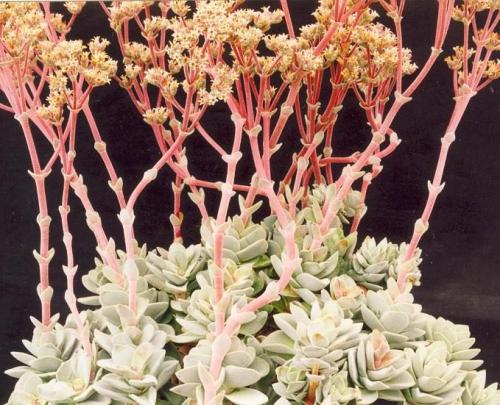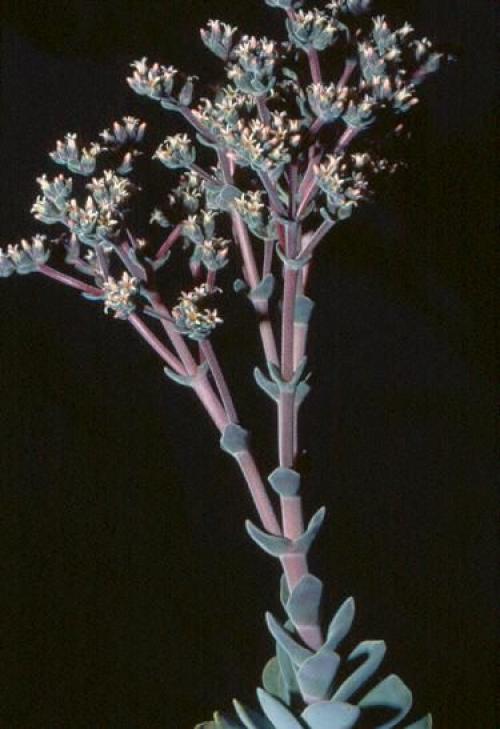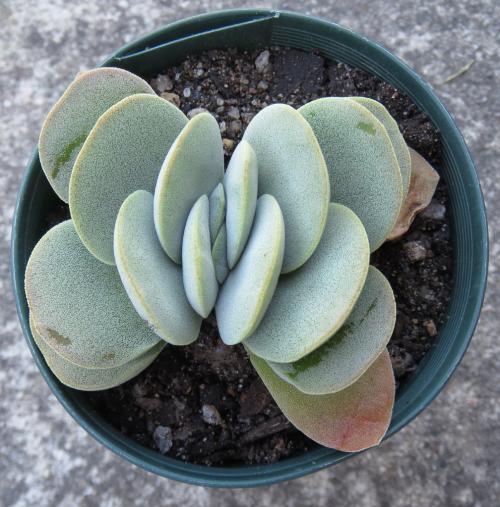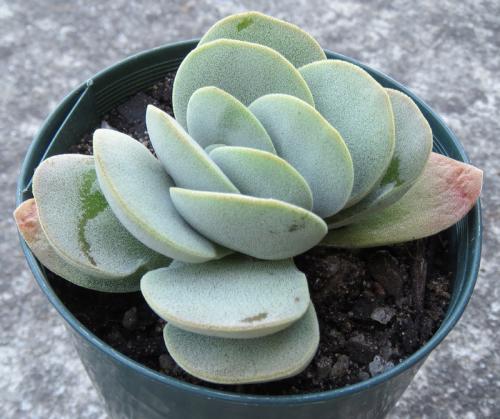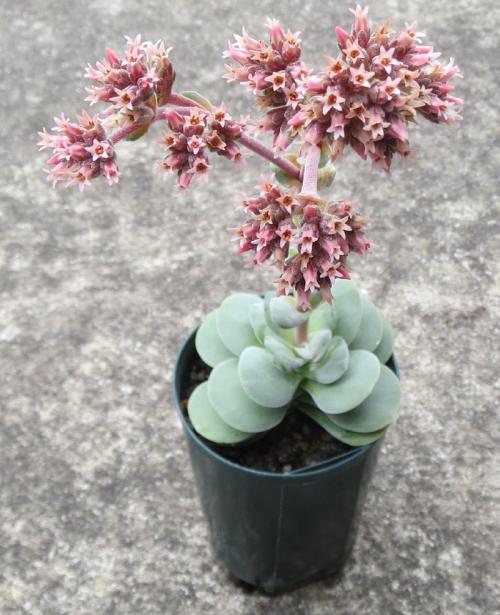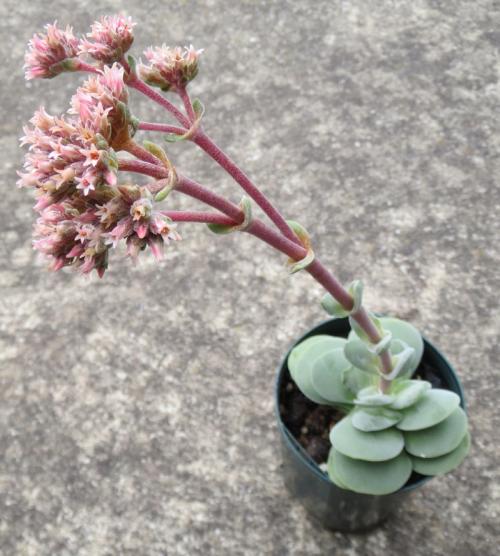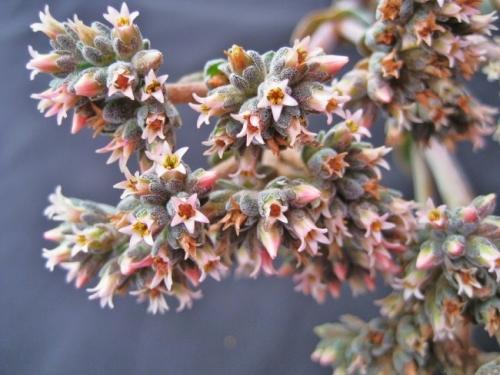Alice Herbert
Created by Max Holmes, Australia.
CRASSULA ‘ALICE HERBERT’ – A NEW HYBRID.
By Max Holmes
Quite a few of my Crassula hybrids turn out to be ugly or uninteresting. Seedlings which show promise can grow into adult plants which fail to excite the imagination, and end up in the garbage bin. The subject of this article however, did just the opposite.
It started by looking a bit like C. ‘Morgan’s Beauty’, or possibly C. ‘Coralita’, and I watched it grow with decreasing interest as the months went by. After two years it started to develop a flower stem, so I decided to postpone its execution until it flowered. I’m glad I did!
It is a cross between C. tomentosa v. tomentosa and C. ‘Coralita’, which is C. susannae x C. perfoliata v. falcata. I don’t know which is the seed parent. This hybrid produces rounded leaves about 3 cm wide, 4 cm long and 5 mm thick, in a stemless rosette. The leaves are either flat or slightly concave on the upper surface, and slightly convex on the lower surface, and are covered all over with papillae, giving them a grey appearance. The papillae are actually stubby, recurved hairs, but this is not evident unless a low-power microscope is used, and they are not quite so densely clustered near the leaf bases. The plant slowly forms a stemless cluster of rosettes, offsetting from both the base of the plant and the base of the flower stem after flowering. Unlike C. tomentosa, it does not die back after flowering, but continues to grow strongly.
In winter the flower stem develops. It is very robust, up to 7 mm thick and about 19 cm long, covered with similar short hairs to those on the leaves. Despite producing many flowers, the peduncle is usually strong enough to remain upright. The bracts are similarly grey-coated, large, fleshy and leaf-like, gradually decreasing in size up the stem. The bases of the bracts are fused together into a sheath up to 5 mm long. The peduncle produces several subsidiary peduncles, each terminating in dense clusters of sessile flowers with fleshy, hairy sepals. It is this large, well-branched inflorescence which immediately sets the hybrid apart from others which produce somewhat similar rosettes. The flowers open in August (Australia). They are about 6 mm long and 5 mm wide, very pale pink, shading to pale yellowish in the throat. The petals are quite narrow and recurve widely after a few days, giving the flowers a starry appearance.
The tall, many-flowered inflorescence is presumably the result of influence of C. tomentosa and to some extent, C. perfoliata v. falcata and suggests that C. tomentosa might usefully be crossed with other crassulas. Having seen the results here, I have started doing this.
Crassula ‘Alice Herbert’ is easy to grow and gives no cultivation problems, at least in my climate, but may not be quite so easy in more humid climates. I suggest that it be given plenty of fresh air in summer to minimize development of spots on the leaves. It will strike easily from leaves or bracts, and is in fact the first crassula I have been able to propagate reliably from bracts.
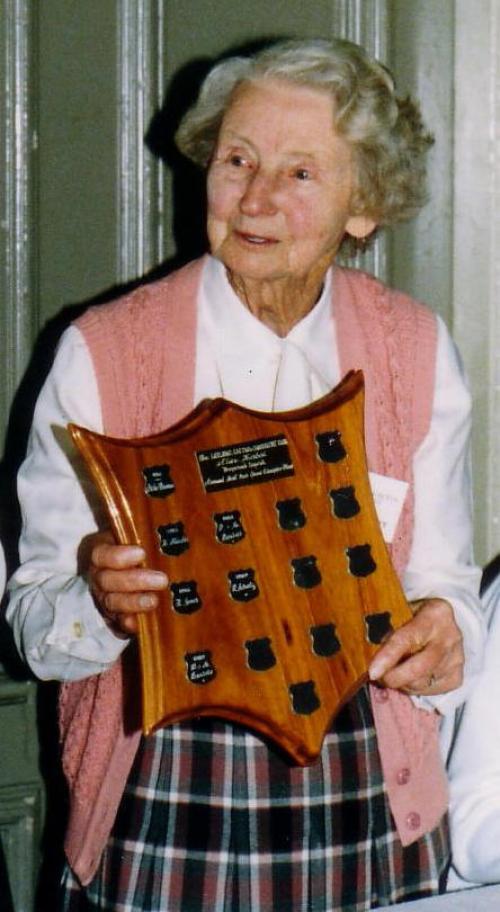
I have decided to name this very distinctive hybrid in memory of Mrs Alice Herbert, who died in 1995. For many years she was a valued member of the Geelong Cactus and Succulent Club and a keen grower of Crassulaceae.
(Article published in the Geelong Cactus and Succulent Club newsletter of Oct. 1997, and the Cactus and Succulent Society of NSW newsletter of Dec. 1996.)
